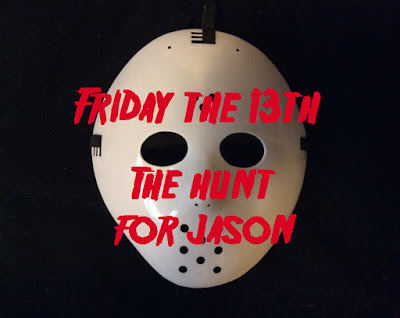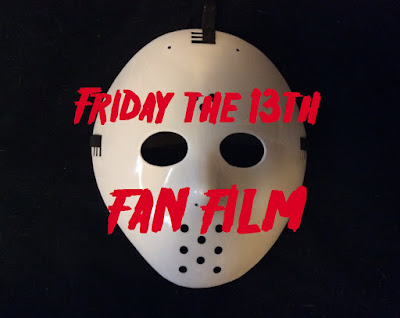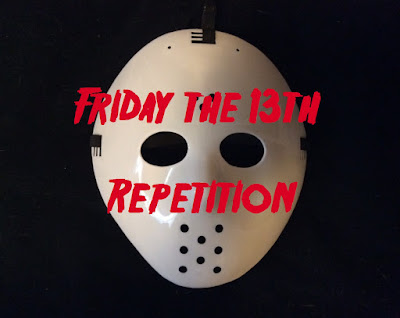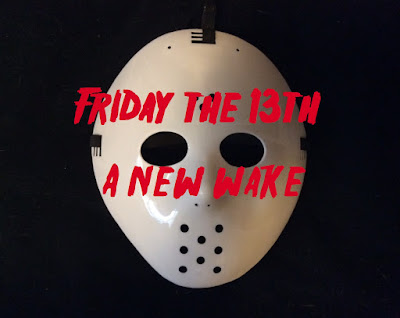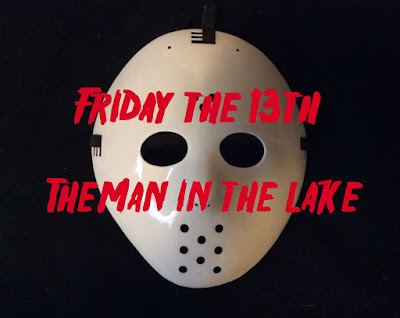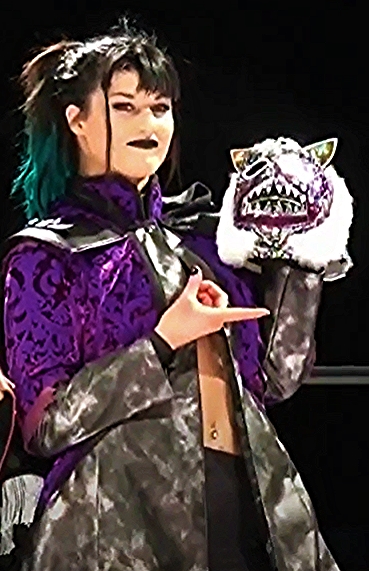Watch it here.
Monday, December 13, 2021
Friday the 13th: The Hunt for Jason
Saturday, November 13, 2021
Friday the 13th: Fan Film(s)
Watch the bad one here. Don't watch the terrible one anywhere.
Wednesday, October 13, 2021
Camp Crystal Lake
Watch it here.
Thursday, September 30, 2021
2000 Maniacs! (1964)
I just watched 2000 Maniacs! and by god is that a prescient film. It's redneck horror at its most carnivalesque.
Herschell Gordon Lewis looks eminently prophetic as his 1964 film sets a template for a subgenre of horror that would thrive in the 1970s. Texas Chainsaw Massacre would give us the male remnants of a family of cannibalistic rednecks living just off the main road. The Hills Have Eyes would give us an extended family and/or clan of inbred hicks cannibalizing wayward travellers. Both of these films are better made and more artistically sophisticated than 2000 Maniacs!. But Lewis's film is more demented and visceral: after all, it gives us not a family or a clan but rather a whole town of Southerners, all 2000 of whom are berserk and bloodthirsty and cannibalistic, at least when dealing with Northerners.
And so the film presents us with the multifarious maimings of our Yankee protagonists, making way for a tide of that orangey blood that was a hallmark of Lewis's films. Oh, sure, there's dismemberment and cannibalism, but for me, the piece-de-resistance comes when the locals cajole a Yankee man into a barrel under the pretext that they’re going to roll him down a hill in good fun. This is a risky enough proposition to begin with, but then the yokels gleefully proceed to drive nails through the barrel. By the time the Yankee gets to the bottom of the hill, he's no more than a shredded, red-orange rag. The rednecks rejoice. They have collaborated successfully on a slaughter.
The psychiatric holding-tank, then, is the South itself, and every single son and daughter of the soil can be counted as one of the inmates. They betray an unabashed giddiness as they mutilate. They exude joie-de-vivre while they deprive their Northern countrymen and women of their lives. This is inestimably jarring.
So while Texas Chainsaw Massacre and The Hills Have Eyes are better films, hands down, the former more artistic and the latter far more tightly plotted, 2000 Maniacs! is more horrifying. To stare into that joyous, murderous, and cannibalistic Southern horde is to stare into the faces of our present-day countrypersons. It is to stare into the faces of the Trump supporters and, more recently, the anti-maskers and the anti-vaxxers. Sorry Leatherface, but real-life horror doesn’t wear a mask.
And while the film sort of cops out at the end by suggesting (spoiler alert) hallucinatory or supernatural causes for the town with the eponymous population of 2000 sadistic rednecks, the implication is very real. There are people like this in our country, not just thousands of them but millions of them. They are the abscess on America that will never die. Worse yet, they are a cancer that might just kill you—that might just eat you alive.
Monday, September 13, 2021
Friday the 13th: The Legacy Begins
*CEGEP refers to the mandatory year of pre-University college undertaken by Quebecois students.
Friday, August 13, 2021
Friday the 13th: The Curse of Jason
Friday the 13th: Repetition
Tuesday, July 13, 2021
Friday the 13th: A New Wake
Saturday, June 12, 2021
Friday the 13th: Extraction
Thursday, May 13, 2021
Friday the 13th: No Man's Land
Monday, April 12, 2021
Friday the 13th: The Man in the Lake
Sunday, April 11, 2021
Bea Priestley: An Appreciation
[B]osom heaving, her eyes flashing [...] [s]he was slender, yet formed like a goddess: at once lithe and voluptuous. [...] Her rich black hair, black as a Stygian night, fell in rippling burnished clusters [...] Her dark eyes burned [...]. She was untamed as a desert wind, supple and dangerous as a she-panther.
- Robert E. Howard
1.
You likely haven't heard of her, yet you know her already. You want to have known her. She's that girl with the Kool-Aid-colored hair smoking cigarettes at the school's rear entrance.
She is Queen of the Black Coast and beyond. Robert E. Howard couldn't have conjured a more consummate vamp, not in his most vivid, virginal reverie, not in his spiciest of stories. The epigraph above does her little justice. H. Rider Haggard could have done little more to comprise her, though with his sorceress Ayesha—the eponymous “She” from his famed novel—he draws nearer.
She hails from Wellington, NZ, by way of London. She bills herself the "Top Gaijin." At its most euphemistic, “Gaijin” translates from Japanese as "foreigner." At its most xenophobic, "Gaijin" can be rendered "outsider" or "alien." She is outside, yes, but also far above.
Her signature finish is the electric chair suplex. She calls it the "Queen's Landing," and with good cause. One of the most ascendant male wrestlers in the world is her male suitor, and she and he seem apt heirs apparent for wrestling royalty.
The "She" in question is Bea Priestley, grossly underappreciated wrestler for whom I am now about to attempt an appreciation.
2.
You might mock professional wrestling, and you are mostly justified in doing so. The wrestling you've glimpsed briefly and dismissed, perhaps while flipping channels, is all defined by some measure of compromise. There is little compromise in Bea Priestley.
I saw her holler "fuck off" at a male fan who wolf-whistled as she exuviated her entrance robe. With that, I fell hard into her fandom.
3.
I think a lot about Bea Priestley's bumps. They have such force and gravity. They are unrelenting. They paralyze the gaze. Her bumps inspire. Her bumps titillate. Her bumps look so painful, yet they ease my pain.
I once saw a bump of Bea's where her head was caught up in a chair and then the face she was facing kicked her stiffly sans abandon (see below). I once saw Bea Priestley take multiple head-bumps, including two Tower Hacker Bombs, in a match against Kagetsu in Japan. The internet saw her take an inter-gender kick to the face from Ricochet. Bea Priestley deals in pain so expertly, log-rolling on the canvass, shag of hair roiling, gripping her brain-pan in both palms, selling the hallowed rear-blow-to-head bump.
I watch her bumps and I ache for Bea Priestley. Can't the majority audience, the common public, see what Bea's putting herself through? Can't the talent scouts see what they're missing out on? I ask these questions like these matches aren't widely available on YouTube, like they don't have hundreds of thousands of views. Hundreds of those views are mine, as I can't take my eyes off her bumps.
At this juncture, I should clarify for the non-wrestling fan that, in the wrestling business, "bumps" refer to choreographed landings.
4.
Bea's breakout bout, arguably, was her Last Woman Standing match in which she faced Nixon Newell for the WCPW Women's Championship. You may know Newell as "Tegan Nox," her moniker in NXT, WWE's "gold brand."
Newell, playing the face, came out sweet and enthusiastic and insipid. Newell's given middle-name is Rhiannon, so we must assume that the "Nixon" in her ring name is a Stevie Nicks homage. Any kindred linkage with Nicks, even tangential and/or unconscious, solidifies "crowd-pleaser" status. And Bea quickly established herself as the heartless challenger to the Gold Dust Woman.
Bea Priestley did not merely play the heel; rather, she epitomized it. She entered as the sour-faced silicone Valkyrie, in kick-pad boots and a carapace-like bikini that looked très impractical for pro wrestling.
Of course, Bea and Newell did not wrestle in any conventional sense. From the outset of the match, Bea wielded a kendo stick as liberally as she did her middle finger, dealing out many a thwack to the fawn-faced Newell.
The eroticized nature of the beating was never lost on the mostly male crowd or on Bea. At one point, Bea took the liberty of licking Newell across the face before slapping her with an open palm. The homology drawn by these consecutive indignities was virtuosic, both the tongue and the slap like unto a paintbrush across Newell's face.
Bea would eventually bring steel chairs into the ring in the promise of a massive, maleficent spot to finish the match. She would be hoisted by her own petard. Newell grabbed back the momentum and German-suplexed Bea onto the chair. It was this chair into which Bea's head was fed, and here (all kayfabe aside) where Bea laid dutifully on her cheek such that Newell could curb-stomp her ala Seth Rollins and then, only then, veritably Pillmanize Bea Priestley via an unprotected kick to the face. How many male wrestlers would take that bump?
Of course, the referee's count climbed to ten and Nixon Newell was the winner. She would go on to NXT, to be given her new name, and to flounder in the gears of the WWE machine, one among many gold dust women who would have their illusions shattered by that corporate entity and its capricious septuagenarian overlord, that reverse-alchemist who unfailingly makes lead from gold.
But Bea Priestley's name, by contrast, became elemental and immutable from that evening onward.
5.
I like Bea Priestley because she is not easy to like. She is a challenge. There is an offensive quality inhering within her. At times, her in-ring work verges upon appearing unworkable. In each gesture, she betrays some measure of disdain for the pageantry surrounding the pseudo-sport of wrestling itself.
She gives no indication of caring what the fans think. It is as if we the fans were chewing gum to be gnashed and spat out (or perhaps, once thoroughly chewed, placed in an opponent’s mouth, a tactic Bea used to intensify a camel clutch in one of her battles with Newell).
Unsurprisingly, Bea Priestley turned down an early WWE contract offer. Bea Priestley is not clay to be shaped. But alas—and, surprisingly—even the relatively progressive shores of All Elite Wrestling couldn't keep her moored. She was too talented and too jaded for WWE—that goes without saying—but even AEW, a company built on being the alternative, could not fully apprehend her acumen. For it must be said that AEW, for all the good it has done, is built in no small measure on fan-service. Bea Priestley is not there to render services for the fans.
Bea Priestley's talent is not in her promos. (She sounds one-half Valley Girl, one-half Cockney bootblack, and tends to get caught up in cursing.) And though her in-ring work is solid, this is not the locus of her talent, either. Her talent is her presence. A buxom woman with green lipstick is going to strut down the ramp with a wide and manly swagger, as if making way for comically large testes, and then is going to work stiff. Just ask brittle Britt Baker, whose skull fell victim to Bea Priestley’s rumbustious boot. (I say this not to take anything away from Dr. Baker, whose recent "Lights Out" match with Thunder Rosa marked a tidal shift for women's wrestling.)
Bea Priestley does not map on to any recognizable wrestling archetype. She is indeed Top Gaijin, but not just in Japan. She is an outlander in any federation or confederacy. She is a feral, strong-style mercenary in a milieu of fake fights.
Bea Priestley could be a female Bruiser Brody. This is both high praise and a death warrant.
6.
When grown men wax literary about female celebrities, the reader can safely presume the male author is having some sort of sexual fantasies about said celebrity women. Indeed, Norman Mailer wrote an entire volume about a decades-dead Marilyn Monroe that was rather frank in its sexual reveries.
Vis-à-vis Bea Priestley, this is not the case for me. Rather, in my fantasies, I call to mind a world in which Bea Priestley and I are, like, acquaintances at best. I spend a lot of our time together fawning over the high spots and head-drops in her matches. She is not forthcoming with chitchat, but she mostly talks about how busy it is being on the road in four continents, and about the challenges of maintaining a romantic relationship within the business. Sometimes, I mention my own dating woes—the lack of dates one presumes of men who write lovingly about female celebrities—and Bea Priestley sneers and says "well then try getting your fat fucking arse to a gym."
"Oh, Bea," I then say. (And this is also a Norman Mailer reference; cf. Mailer: His Life and Times, p. 72. The first of Mailer's six wives (a) was also named Bea and (b) was also foul-mouthed.)
To make this fantasy world even remotely plausible, in it I am necessarily employed in the pro-wrestling industry. I picture I am Bea Priestley's manager, my hit-or-miss articulateness subbing in for her mediocre mic skills. I berate her scheduled opponent, and then she finishes the pre-match segment by berating me. I refer to her as She-Who-Must-Be-Obeyed. The commentators speculate as to our relationship, the persistent question in this fantasy world being: am I Bea Priestley's gimp? It's obvious to everyone this relationship can't possibly be romantic, and would still be obvious even if she wasn't involved with Will Ospreay.
7.
If you want to see the future of wrestling and romantic relationships, you must watch Bea Priestley versus Will Ospreay. A boyfriend vs. girlfriend match may smack of exploitative fluff, for this was certainly the precedent set by WWE in less progressive times (cf., for instance, Marc Mero vs. Sable). Some may dismiss Priestley vs. Ospreay as desperate content creation from the early COVID-19 era. But it is not to be dismissed. It is arguably a five-star match.
Priestley takes to the ring with ratty Kool-Aid colored pig-tails swishing, a bad-ass Raggedy Ann in laced tights and a halter top. Ospreay has more flash and gasconade. But Bea Priestley slaps that gasconade off Ospreay's face early on with many a resounding shoot-style strike, and the beau quickly sheds his self-assured smile.
In due course, Priestley takes a resounding slap to the chest. Ospreay begins to assert his size advantage, playing to every conservative’s expectations.
But then Priestley turns the tides with what is possibly the best DDT ever executed onto the ring apron—the hardest part of the ring (if you ignore the posts). As her male suitor staggers to his feet on the ringside mats, Priestley follows up with a double foot-stomp to the back. Flying from the turnbuckle to the outside, she looks every bit Belît, Howard's "wildest she-devil unhanged." Yet her exit route leaves her with no choice but to take an excruciating back bump on the floor. After this, moaning and almost in tears with pain, she manages to get her boyfriend back in the ring to score a near-fall.
Of course, Ospreay charges back, and soon enough he's hooked Bea's arms and secured her shaggy mop between his legs so as to presage the Storm Breaker, his A-level finisher. And then, even after all the beating she has taken, Bea counters the Storm Breaker into a Code Red. And then when Ospreay goes to his other A-level finisher, the Os-Cutter, Bea counters with a bottom-rope-aided German suplex. This is all fantastic.
So now Ospreay has to resort to his A+ finisher, his top-tier signature move, the rarely seen "Hidden Blade." It is only after he succeeds with this glorified knife-edge chop that he is able to execute the Storm Breaker and score the pinfall. The Storm Breaker—that double underhook corkscrew neckbreaker—strikes me now as the truest consummation of a relationship.
The match could be five-stars. It loses at least a half-star, however, for Ospreay's male-gazing contemplation of Priestley’s felled, face-down body, and his subsequent consideration of grabbing some sweet. Thankfully, he thinks better of it, but even the mere ideation of a goosing takes the match down a notch.
Yet the match we have just watched cannot be reduced to a mere gazing and enumerating of stars. What we have witnessed obviates words, attesting to what is really the most transcendent intercourse: to meet your significant other in a choreographed fight. This is what a romantic relationship should culminate in. The goal of coupling is not a happy, long-lived marriage or, I don't know, a quasi-mystical sexual encounter. Rather, it is a worked, twenty-plus minute battle, and a strong-style fight at that.
This is love. And due to a raging plague, no one got to see it live.
8.
I've thought a lot about women I've loved or could have loved, and I've dreamed of strong-style bouts with them. Would I put them over? How would I get myself over? Would they put me over? How would I bump for them? Would I let them roll me up in the highest of high-stack pinfalls? Even if you don't let them beat you, you must make your lover look good.
9.
There are several female celebrities I greatly admire. These include Lana Del Rey, Stevie Nicks, Serena Grandi (Italian b-movie luminary, FYI), and, what the hell, we'll throw Amanda Seyfried in there too. I've considered writing long-form pieces about all of these people (with the exception of Seyfried), but in the end I chose to write about Bea Priestley. Why? Because I imagined—as all people who write about people they admire but will never meet must—the person being written about somehow actually reading the work.
In the above cases, there is the possibility, admittedly slim, that the person in question could like what I wrote about them. But Bea Priestley is the outlier. There's not going to be some personalized tweet about how "you're so sweet." Bea Priestley does not give a fuck what I think and would appear to be wholly incapable of ever giving a fuck what I think. All of my above praises would matter no more to her than that male-gazing Britisher who wolf-whistled at her lissome body as she bared it.
And I admire that complete disdain for the fan. Because the fan is ultimately a spectator partaking in something altogether lower than watching or observing or gazing. They watch with empty-headed expectation of being entertained. This is, for lack of a better term, "spectation." Fans are defined by their maniacal commitment to observing exalted others in this way. That Bea Priestley hates this makes me like her all the more.
Because I hate being a fan of anything or anyone. It pains me that, as someone who believes that what he thinks is worth writing down, I would even consider writing about any of the aforementioned celebrities. Their talents do not make them exalted or transcendent. Our worship for the marketing of their talents is what keeps them afloat, and this worship makes us so irredeemably common, insofar as we would accept such a low standard for transcendence.
Bea Priestley's thesis, if she has one, is almost an argument against spectating itself. This, to my mind, makes her wrestling's perfect heel.
That is Bea, that is Belît. The name bewilders you and so you dismiss it, you forget it.
I whisper that name like a prayer, while I pray that Bea Priestley will not be the female Bruiser Brody, that she will not end up as wrestling's Marilyn Monroe. I pray that all her bumps will land true, and that her stingers, when they happen, will heal and feeling will return even fuller than before. I pray that one day some promotion will see that there is something generational, something elemental, something eternal in Bea Priestley. I pray that you will all see this much, and feeling will return to you, too.
Rumor has it that Bea Priestley is headed to NXT, that most palatable tentacle of WWE. Specifically, she'll be in NXT UK, a tameless outlander shoehorned back into her ostensible home. When I hear this, I feel that strange mix of exultation and envy one experiences when a friend has some success. I also feel sorry for her. Because I doubt that WWE can ever truly know Bea Priestley.* Indeed, that feeling she embodies is so subtle, so rarefied, I fear that the WWE creative team cannot fathom it, let alone capture it in the ring.
I mean that feeling that high school's over, and school’s out forever, but still you know She is still there, still smoking at the rear entrance, and that She always will be. You don't know her, but you realize in time that you want more than anything to have known her.
---
Footnotes:
*Update, July 4, 2021: As could be expected, WWE has rebranded Bea Priestley, settling upon the name "Blair Davenport." While certainly maintaining the Britishness of Priestley's given name, WWE Creative has erred on the side of posh British rather than the hard-bitten British of the original. It's some consolation, I suppose, that the last syllable of "Davenport" does maintain Priestley's littoral associations (e.g. her mastery of the "Japanese Ocean" suplex). Still, I personally find that something is lost when someone submits themselves to a pseudonym.
Tuesday, March 16, 2021
The Slider - T. Rex
T. Rex is perhaps best known for their radio-friendly 1971 single "Bang a Gong (Get it On)" from their stellar Electric Warrior LP. That album was the band’s seventh (but their second after abbreviating their name from the less commercially viable "Tyrannosaurus Rex") and marked the height of the band's commercial success. Critics both contemporaneous and retrospective have taken Electric Warrior as the artistic apogee for T. Rex and its virtuoso frontman Marc Bolan, but this is up for debate. T. Rex's 1972 album The Slider proves itself far more expansive than Electric Warrior, benefitting from some of Bolan's most mystically and ontologically sophisticated songwriting.
The Slider starts off with "Metal Guru," one of the record's two singles. While "Bang a Gong (Get it On)" is undeniably top-forty bait, "Metal Guru" is something quite different. Its title belies its content in that it’s not a heavy, hardscrabble jam but rather a jubilant, sing-songy meditation on the titular phrase sung over and over again by a sizable chorus. On account of the cheery bombast and sheer repetition “Metal Guru” offers, it feels as if the album is starting with a vamp—that is, the kind of all-in close-out with which one might end a song or even an album. The reference to a "guru" in the title is apropos, as both the song and the album in its entirety possess a distinctly mantraic vibe. The Slider fixates on phrases as if determined to produce in the listener an altered state.
 |
| Marc Bolan, virtuoso |
The titular track showcases Bolan's psychedelic lyricism at its best. "I could never understand/The wind at all/Was like a ball of love//I could never never see/The cosmic sea/Was like a bumblebee." Here Bolan appears to be collapsing perceptual and linguistic distinctions between phenomena in hopes of moving toward a mystic, quasi-Vedantic state. The bumblebee, then, can indeed be the cosmic sea, when one lets go and proceeds "to slide." As Bolan attests, "And when I'm sad/I slide ." This song, then, is a sonic replication of a psychological and/or religious state. It's an invitation for the listener to slide all the while. Drugs likely were and are implicated in conceptualizing and realizing this state of "The Slider." Knowing Bolan, the main suspect here is cocaine.
Friday, March 12, 2021
Friday the 13th: The Storm
Sunday, February 14, 2021
Minus Forty
